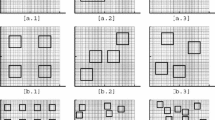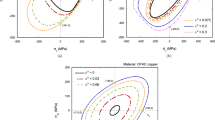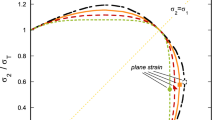Abstract
In this series of papers, we investigate the mechanics of deformation localization and fragmentation in ductile materials. The behavior of ductile metals at strain rates between 4000 and 15,000 s−1 is considered. The expanding ring experiment is used as the primary tool for examining the material behavior in this range of strain rates. In Part I, the details of the experiment and the experimental observations on Al 6061-O were reported. Statistics of necking and fragmentation were evaluated and the process was modeled through the idea of the Mott release waves both from necking and fragmentation. Finally, it was shown that the strain in the ring in regions that strained uniformly never exceeded the necking strain. In the present paper, Part II, we address the issue of strain hardening and strain-rate sensitivity. Specifically, we examine different materials—Al 1100-H14, and Cu 101—in order to determine the role of material constitutive property on the dynamics of necking. These experiments reinforce the conclusion presented in Part I that the onset of necking essentially terminates the possibility of further straining in other parts of the ring and even more importantly that there is no influence of material inertia on the strain at the onset of necking in this wide range of materials. Furthermore, the effect of aspect ratio of the specimen is evaluated; this reveals that as the aspect ratio increases beyond about five, in addition to or instead of diffuse necking, localization into the sheet necking mode is observed; in this mode, the effect of ring expansion speeds is demonstrated to result in an increase of the strain at the onset of localization. In addition, an absolute size effect is observed: larger specimens exhibit localization at larger strain levels. These observations are explained in terms of plastic wave propagation and reproduced with finite element simulations. In future contributions as part of this sequel, we will explore the effect of other geometrical constraints and the effect of a compliant cladding or coating on the development of necking and fragmentation.
Similar content being viewed by others
References
Abeyaratne R, Triantafyllidis N (1981) The emergence of shear bands in plane strain. Int J Solids Struct 17: 1113–1134 doi:10.1016/0020-7683(81)90092-5x
Altynova M, Hu X, Daehn GS (1996) Increased ductility in high velocity electromagnetic ring expansion. Metall Mater Trans A 27A: 1837–1844 doi:10.1007/BF02651933
Chu TC, Ranson EF, Sutton MA et al (1993) Applications of digital-image-correlation techniques to experimental mechanics. Exp Mech 25: 232–244 doi:10.1007/BF02325092
Follansbee PS, Kocks UF (1988) A constitutive description of the deformation of copper based on the use of the mechanical threshold stress as an internal state variable. Acta Metall 36: 81–93 doi:10.1016/0001-6160(88)90030-2
Fyfe IM, Rajendran AM (1982) Inertia effects on the ductile failure of thin rings. J Appl Mech 49: 31–36 doi:10.1016/0001-6160(88)90030-2
Grady DE, Bensen DA (1983) Fragmentation of metal rings by electromagnetic loading. Exp Mech 12: 393–400 doi:10.1007/BF02330054
Gorham DA (1991) The effect of specimen dimensions on high strain rate compression measurements of copper. J Phys D Appl Phys 24: 1489–1492
Gududru PR, Freund LB (2002) The dynamics of multiple neck formation and fragmentation in high rate extension of ductile materials. Int J Solids Struct 39: 5615–5632 doi:10.1016/S0020-7683(02)00367-0
Hall EO (1970) Yield point phenomena in metals and alloys. Plenum Press, NY
Hill R (1952) On discontinuous plastic states, with special reference to localized necking in thin sheets. J Mech Phys Solids 1: 115–142
Hill R, Hutchinson JW (1975) Bifurcation phenomena in the plane tension test. J Mech Phys Solids 23: 239–264 doi:10.1016/0022-5096(75)90027-7
Hudson GE (1951) A theory of the dynamic plastic deformation of a thin diaphragm. J Appl Phys 22(1): 11
Hutchinson JW, Miles (1974) Bifurcation analysis of the onset of necking in an elastic/plastic cylinder under uniaxial tension. J Mech Phys Solids 22: 61–71 doi:10.1016/0022-5096(74)90014-3
Hutchinson JW, Neale KW (1978) Sheet necking—II. Time-independent behavior. In: Koistinen DP, Wang NM (eds) Mechanics of sheet metal forming. Plenum Press, New York, pp 127–153
Kyriakides S, Miller JE (2000) On the propagation of Luders bands in steel strips. J Appl Mech 67: 645–654 doi:10.1115/1.1328348
Leo PH, Shield TW, Bruno OP (1993) Transient heat transfer effects on the pseudoelastic behavior of shape memory wires. Acta Metall Mater 41: 2477–2485 doi:10.1016/0956-7151(93)90328-P
Lu J, Ravi-Chandar K (1999) Inelastic deformation and localization in polycarbonate under tension. Int J Solids Struct 36: 391–425 doi:10.1016/S0020-7683(98)00004-3
Marciniak Z, Kuczynski K (1967) Limit strains in the process of stretch-forming sheet metal. Int J Mech Sci 9: 609–620 doi:10.1016/0020-7403(67)90066-5
Mott NF (1947) Fragmentation of shell cases. Proc Roy Soc Lond Ser A 189: 300–308
Nadai A (1950) Theory of flow and fracture in solids, 2nd edn, vol 1. McGraw Hill, New York
Nemat-Nasser S, Li Y (1998) Flow stress of fcc polycrystals with application to OFHC Cu. Acta Mater 46: 565–577 doi:10.1016/S1359-6454(97)00230-9
Richard K, Graube E (1956) Die Kalrverstreckung be Niederdruck-Polyäthylen. Kunststoffe 46: 262–269
Shaw JA, Kyriakides S (1995) Thermomechanical aspects of NiTi. J Mech Phys Solids 43: 1243–1281 doi:10.1016/0022-5096(95)00024-D
Shenoy V, Freund LB (1999) Necking bifurcations during high strain rate extension. J Mech Phys Solids 47: 2209–2233 doi:10.1016/S0022-5096(99)00031-9
Storen S, Rice JR (1975) Localized necking in thin sheets. J Mech Phys Solids 23: 421–441 doi:10.1016/0022-5096(75)90004-6
Tong W, Clifton RJ, Huang S (1992) Pressure-shear impact investigation of strain rate history effects in oxygen-free high-conductivity copper. J Mech Phys Solids 40: 1251–1294 doi:10.1016/0022-5096(92)90015-T
Triantafyllidis N, Waldenmyer JR (2004) Onset of necking in electro-magnetically formed rings. J Mech Phys Solids 52: 2127–2148 doi:10.1016/j.jmps.2004.02.009
Tvergaard V (1993) Necking in tensile bars with rectangular cross-section. Comput Meth Appl Mech Eng 103: 273–290 doi:10.1016/0045-7825(93)90049-4
Tvergaard V, Needleman A, Lo KK (1981) Flow localization in the plane strain tensile test. J Mech Phys Solids 29: 115–142. doi:10.1016/0022-5096(81)90019-3
Xue Z, Vaziri A, Hutchinson JW (2008) Material aspects of dynamic neck retardation. J Mech Phys Solids 56: 93–113 doi:10.1016/j.jmps.2007.04.003
Zhang H, Ravi-Chandar K (2006) On the dynamics of necking and fragmentation: I. Real-time and post-mortem observations in Al 6061-O 142: 183–217 doi:10.1007/s10704-006-9024-7
Zhou F, Molinari JF, Ramesh K (2006) An elastic-visco-plastic analysis of ductile expanding ring. Int J Impact Eng 33: 1–12 doi:10.1016/j.ijimpeng.2006.09.070
Author information
Authors and Affiliations
Corresponding author
Rights and permissions
About this article
Cite this article
Zhang, H., Ravi-Chandar, K. On the dynamics of necking and fragmentation—II. Effect of material properties, geometrical constraints and absolute size. Int J Fract 150, 3–36 (2008). https://doi.org/10.1007/s10704-008-9233-3
Received:
Accepted:
Published:
Issue Date:
DOI: https://doi.org/10.1007/s10704-008-9233-3




